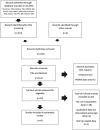What Is Important to the Younger Person (≤50 Years) When Having a Total Hip Arthroplasty: A Systematic Literature Review
- PMID: 37494902
- PMCID: PMC10405792
- DOI: 10.1097/NOR.0000000000000955
What Is Important to the Younger Person (≤50 Years) When Having a Total Hip Arthroplasty: A Systematic Literature Review
Abstract
Total hip arthroplasties (THAs) are usually performed in older patients. Despite a growing number of THAs in younger adults, it is unclear whether they have similar priorities in recovery compared with their older counterparts. The purpose of this systematic review was to explore younger patients' priorities when undergoing a THA. Multiple databases were searched in September 2021 prioritizing qualitative data. This review was reported using the Preferred Reporting Items for Systematic reviews and Meta-Analyses (PRISMA) guidelines. Of 14,495 articles screened, nine remained for analysis. Four common themes were discovered: improving function and mobility; pain; relationships; and patient expectations and education. However, there was insufficient information to clarify whether these themes could be attributed directly to younger adults undergoing a THA. The absence of research on THA patients younger than 50 years results in the loss of the voices of these patients. Further research is essential to ensure their needs are identified, addressed, and met.
Copyright © 2023 The Authors. Published by Wolters Kluwer Health, Inc.
Figures
Similar articles
-
Assistive devices, hip precautions, environmental modifications and training to prevent dislocation and improve function after hip arthroplasty.Cochrane Database Syst Rev. 2016 Jul 4;7(7):CD010815. doi: 10.1002/14651858.CD010815.pub2. Cochrane Database Syst Rev. 2016. PMID: 27374001 Free PMC article.
-
Surgical interventions for treating intracapsular hip fractures in older adults: a network meta-analysis.Cochrane Database Syst Rev. 2022 Feb 14;2(2):CD013404. doi: 10.1002/14651858.CD013404.pub2. Cochrane Database Syst Rev. 2022. PMID: 35156192 Free PMC article.
-
Can We Enhance Shared Decision-making for Periacetabular Osteotomy Surgery? A Qualitative Study of Patient Experiences.Clin Orthop Relat Res. 2025 Jan 1;483(1):120-136. doi: 10.1097/CORR.0000000000003198. Epub 2024 Jul 23. Clin Orthop Relat Res. 2025. PMID: 39051876
-
Falls prevention interventions for community-dwelling older adults: systematic review and meta-analysis of benefits, harms, and patient values and preferences.Syst Rev. 2024 Nov 26;13(1):289. doi: 10.1186/s13643-024-02681-3. Syst Rev. 2024. PMID: 39593159 Free PMC article.
-
Total hip replacement and surface replacement for the treatment of pain and disability resulting from end-stage arthritis of the hip (review of technology appraisal guidance 2 and 44): systematic review and economic evaluation.Health Technol Assess. 2015 Jan;19(10):1-668, vii-viii. doi: 10.3310/hta19100. Health Technol Assess. 2015. PMID: 25634033 Free PMC article.
Cited by
-
Young Hip: an exploration into young patients' (aged < 50 years) expectations following primary total hip arthroplasty : a qualitative study.Bone Jt Open. 2025 Jul 14;6(7):807-815. doi: 10.1302/2633-1462.67.BJO-2025-0013.R1. Bone Jt Open. 2025. PMID: 40653929 Free PMC article.
-
Satisfaction rates, function, and return to activity following young adult total hip arthroplasty.Bone Jt Open. 2024 Apr 15;5(4):304-311. doi: 10.1302/2633-1462.54.BJO-2024-0005.R1. Bone Jt Open. 2024. PMID: 38616049 Free PMC article.
-
The degree of pre-operative osteoarthritis is associated with outcome following THA.Arch Orthop Trauma Surg. 2025 Mar 28;145(1):215. doi: 10.1007/s00402-025-05813-z. Arch Orthop Trauma Surg. 2025. PMID: 40153072
References
-
- Baker P., Coole C., Drummond A., Khan S., McDaid C., Hewitt C., Kottam L., Ronaldson S., Coleman E., McDonald D. A., Nouri F., Narayanasamy M., McNamara I., Fitch J., Thomson L., Richardson G., Rangan A. (2020). Occupational advice to help people return to work following lower limb arthroplasty: The OPAL Intervention Mapping Study. Health Technology Assessment, 24(45), 1–408. 10.3310/hta24450 - DOI - PMC - PubMed
Publication types
MeSH terms
LinkOut - more resources
Full Text Sources
Medical
Miscellaneous


